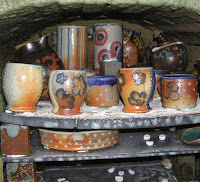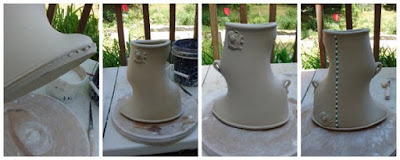 |
| Ugly, right? |
Here's my slab, all rolled out. I like a rolling pin for this; I find it compresses better than either a slab roller or the toss & stretch method. (I am going to type variations on the word "compress" a tedious number of times, but it can't be said often enough: if you are making flat things, compression is key to avoid warping and cracking.) I roll on both sides, flipping often, in several different directions, because why? Congregation calls back: "COMPRESSION!"
Can I get a witness?
I especially like those big, heavy, solid maple rolling pins, but that is partly aesthetic. I love a good tool. But I digress.
Once the slab is rolled to about 3/16ths of an inch, it's time for more compression! A flexible metal rib is best at this wet stage. Both sides, several directions.
I used food coloring to paint out the numerals.
Just for the pretty, I decided to texture my numbers with this roller I got from MKM tools. I make most of my own rollers, out of clay, but MKM has some nice ones. They are also just lovely little objects, so sometimes I can't resist. Again, beautiful tools make me happy.
I place another bat on top of the slab while it is drying to a leather hard stage. My studio is quite cool overnight - low 50s - so it isn't necessary to cover it with plastic, but if yours is a more usual indoor temperature, you probably should drop a sheet of plastic loosely over top. The weight of the second bat, and the absorbency - do not use plastic bats for this! - will help prevent warping.
If I need to turn the slab over, I do so by holding both bats like a sandwich and flipping the slab between the bats.
Once the slab is early leatherhard, it's time to - you guessed it! - compress some more. Flip (using the bat-sandwich method) and compress the smooth side. A very bendy rubber rib is best at this point. I like those red gummy ones, I forget the manufacturer - Mudtools, maybe?
It's time to flip the bat sandwich again, then remove the top bat and cut the numbers.
Remove the slab from around the numerals, not the other way around.
The edges will need extra attention - I run a fingertip over them to smooth and compress. Now: STEP AWAY FROM THE CLAY.
These will want to dry slowly with plastic loosely over top.
Once they are firm enough that I can move them without bending them, but not yet brittle (a fairly narrow window, with thin items) I will want to make holes in them for the screws. I know, I know - thanks, Captain Obvious! - but I have been known to forget this step.
I slide the numeral to the edge of the bat, so I can drill the hole while still allowing most of the piece to be supported. A drill bit makes the tidiest hole, but a fettling knife will work in a pinch.
Now there's nothing left but the drying: again, slowly, lightly covered. On drywall, if possible; if not, a sheet of newspaper helps to wick away moisture from the underside, so the top doesn't dry faster and cause curling or warping.
Now that these are in progress, I can't wait to replace the ugly old ones. It's a mystery to me why I waited so long to do this!



























































